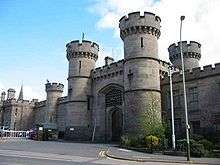Derby Gaol
The term Derby Gaol historically refers to the five gaols in Derby, England. Today, the term usually refers to one of two tourist attractions, the gaol which stood on Friar Gate from 1756 to 1846 and the cells of which still exist and are open to the public as a museum, and the 1843 to 1929 Vernon Street Prison whose impressive frontage can still be seen today.
History
In 1652 the Cornmarket Gaol (no longer extant) was the site of the imprisonment of George Fox on charges of blasphemy. Fox became the founder of the Christian denomination the Religious Society of Friends, perhaps better known as the Quakers. It has been alleged that Judge Bennett of Derby first used the term Quaker to describe the movement, as they bid him to 'quake for fear of the Lord', but the phrase had already been used in the context of other religious groups so the etymology is dubious.
The last person to be hanged at Derby Gaol was William Slack on 16 July 1907 for the murder of Lucy Wilson.
Friar Gate Gaol
The Friar Gate Gaol was site of many hangings, and a small museum today displays contemporary accounts of the executions, a replica of the gallows which stood in front of the building, and a display in crime and punishment in Derbyshire, with a fine collection on the Pentrich Martyrs of 1817, who were hanged and beheaded following their failed revolution on charges of treason in front of the building.
Allegedly haunted, the building was visited in 2002 by Living TV's Most Haunted. The site is today maintained by Richard Felix formerly of Derby Heritage Centre. The gaol is now run by his son Edward and there are plans to knock through the building next door to open up more cells to the public. The Derby ghostwalks are now run from the gaol following Richard's sale of the heritage centre.
The New County Gaol (Vernon Street Prison)
The Vernon Street Prison served as the County Gaol from 1843 to 1919, at which time it was demolished. The last public execution at Derby of Richard Thorley for the murder of Eliza Morrow took place here in 1862. From 1919 to 1929 the prison acted as a military prison. Following the demolition the site served as a greyhound racing stadium, and today contains prestige offices, though the magnificent frontage is worth seeing.
Notable prisoners
- Jeremiah Brandreth - High Treason
- Humphrey Berisford - Recusant
References
- ↑ Derby Reporter (1847-04-02). Derby Gaols Hangings, 1732 to 1847.
External links
Coordinates: 52°55′29″N 1°29′16″W / 52.92472°N 1.48778°W
